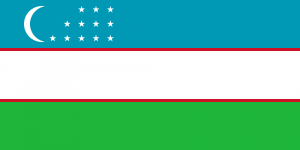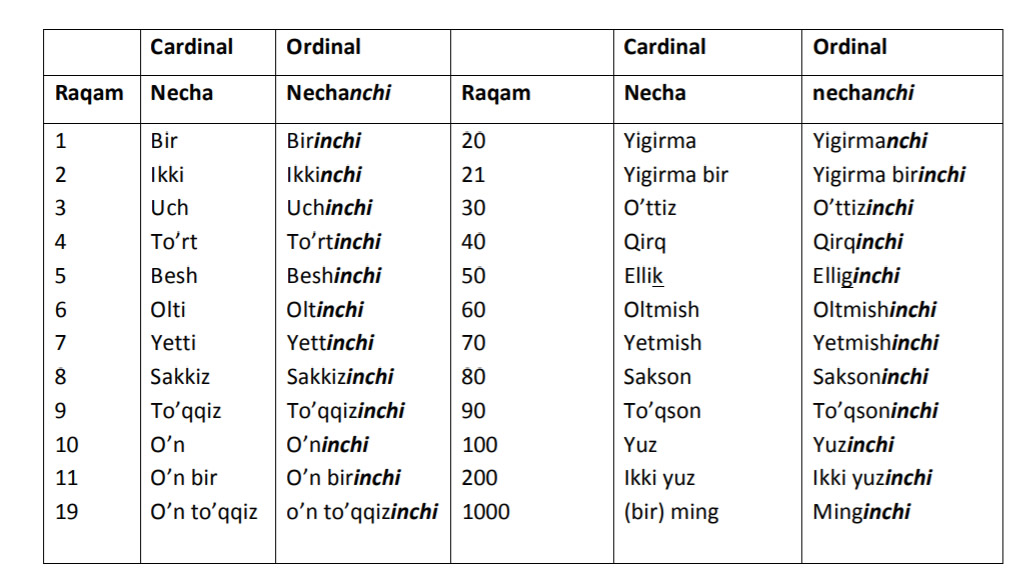Difference between revisions of "Language/Northern-uzbek/Vocabulary/Cardinal-and-ordinal-numbers"
m (Quick edit) |
|||
| (2 intermediate revisions by 2 users not shown) | |||
| Line 1: | Line 1: | ||
[[File:Uzbek-Language-PolyglotClub.png|thumb]] | [[File:Uzbek-Language-PolyglotClub.png|thumb]] | ||
In Uzbek language numbers from 1 to 10 are unique words. But numbers from 11 and upwards are formed by using the following pattern: for example 11 can be formed by using 10 + 1 while connecting them, 12 can be formed by using 10 + 2 and so on. 4.1. | In Uzbek language numbers from 1 to 10 are unique words. But numbers from 11 and upwards are formed by using the following pattern: for example 11 can be formed by using 10 + 1 while connecting them, 12 can be formed by using 10 + 2 and so on. 4.1. | ||
Ordinal numbers in Uzbek language tell the order of things and their rank: my first teacher. | Ordinal numbers in Uzbek language tell the order of things and their rank: my first teacher. | ||
They tell the order of things in a set: first, second, third, etc. | They tell the order of things in a set: first, second, third, etc. | ||
Ordinal numbers do not show quantity. Ordinal numbers are formed by help of suffix – nchi or –inchi after consonants. | Ordinal numbers do not show quantity. Ordinal numbers are formed by help of suffix – nchi or –inchi after consonants. | ||
In the sentences they look like <code>Number+nchi/inchi + Noun</code>. | |||
In the sentences they look like Number+nchi/inchi + Noun. | |||
For example: | For example: | ||
| Line 21: | Line 15: | ||
If it is a compound numeral then each numeral is written separately. | If it is a compound numeral then each numeral is written separately. | ||
For example: | For example: | ||
*Yigirma birinchi uy. – House [number] twenty one. | *Yigirma birinchi uy. – House [number] twenty one. | ||
[[File:uzbek-cardinal-and-ordinal-numbers-PolyglotClub.jpg]] | [[File:uzbek-cardinal-and-ordinal-numbers-PolyglotClub.jpg]] | ||
<span link>Take a moment to explore these relevant pages as you conclude this lesson:</span> [[Language/Northern-uzbek/Vocabulary/Education|Education]], [[Language/Northern-uzbek/Vocabulary/How-to-say-Good-Bye%3F|Say Goodbye in Northern Uzbek]], [[Language/Northern-uzbek/Vocabulary/Food-and-Drink|Food and Drink]] & [[Language/Northern-uzbek/Vocabulary/Languages|Languages]]. | |||
==Source== | ==Source== | ||
https://slaviccenters.duke.edu/sites/slaviccenters.duke.edu/files/file-attachments/uzbek.original.pdf | https://slaviccenters.duke.edu/sites/slaviccenters.duke.edu/files/file-attachments/uzbek.original.pdf | ||
==Other Lessons== | |||
* [[Language/Northern-uzbek/Vocabulary/Numbers|Numbers]] | |||
* [[Language/Northern-uzbek/Vocabulary/How-to-Say-Hello-and-Greetings|How to Say Hello and Greetings]] | |||
* [[Language/Northern-uzbek/Vocabulary/Food|Food]] | |||
* [[Language/Northern-uzbek/Vocabulary/Days-of-the-Week|Days of the Week]] | |||
* [[Language/Northern-uzbek/Vocabulary/Time|Time]] | |||
* [[Language/Northern-uzbek/Vocabulary/Solving-a-misunderstanding|Solving a misunderstanding]] | |||
* [[Language/Northern-uzbek/Vocabulary/How-to-introduce-yourself|How to introduce yourself]] | |||
* [[Language/Northern-uzbek/Vocabulary/Animals|Animals]] | |||
* [[Language/Northern-uzbek/Vocabulary/Asking-for-directions|Asking for directions]] | |||
* [[Language/Northern-uzbek/Vocabulary/Family|Family]] | |||
<span links></span> | |||
Latest revision as of 13:06, 27 March 2023
In Uzbek language numbers from 1 to 10 are unique words. But numbers from 11 and upwards are formed by using the following pattern: for example 11 can be formed by using 10 + 1 while connecting them, 12 can be formed by using 10 + 2 and so on. 4.1.
Ordinal numbers in Uzbek language tell the order of things and their rank: my first teacher.
They tell the order of things in a set: first, second, third, etc.
Ordinal numbers do not show quantity. Ordinal numbers are formed by help of suffix – nchi or –inchi after consonants.
In the sentences they look like Number+nchi/inchi + Noun.
For example:
- Mening birinchi o’qituvchim.- My first teacher.
If it is a compound numeral then each numeral is written separately.
For example:
- Yigirma birinchi uy. – House [number] twenty one.
Take a moment to explore these relevant pages as you conclude this lesson: Education, Say Goodbye in Northern Uzbek, Food and Drink & Languages.
Source[edit | edit source]
Other Lessons[edit | edit source]
- Numbers
- How to Say Hello and Greetings
- Food
- Days of the Week
- Time
- Solving a misunderstanding
- How to introduce yourself
- Animals
- Asking for directions
- Family

